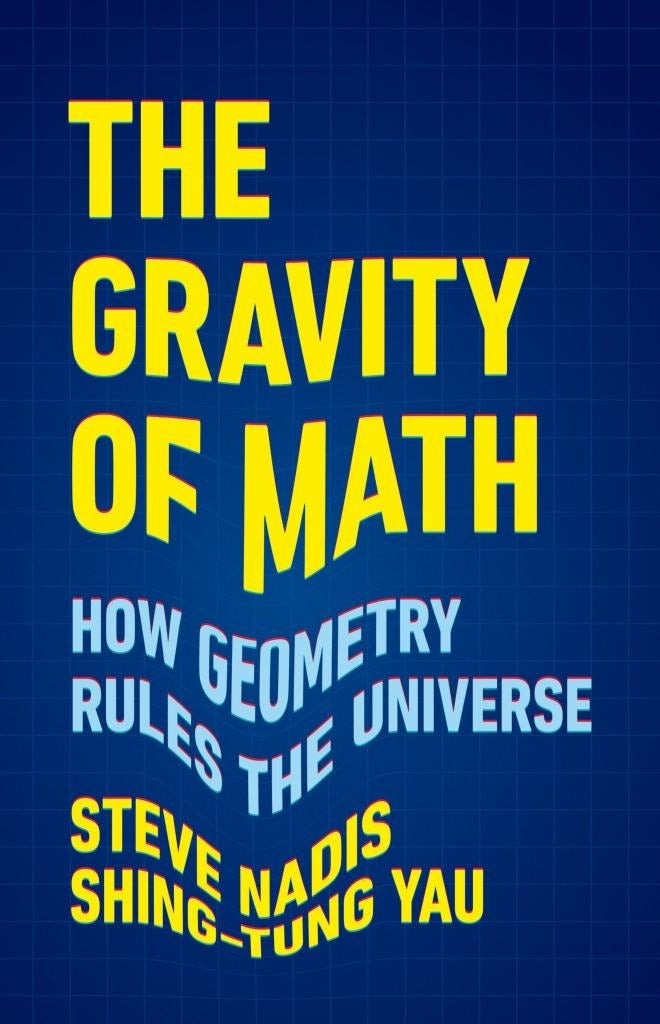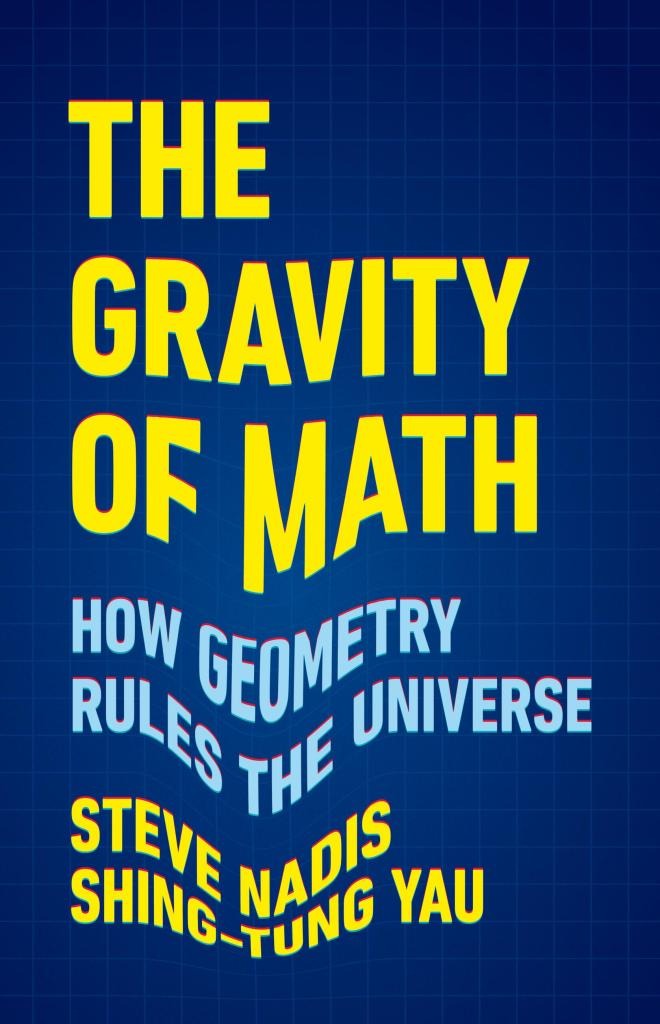
The Gravity of Math: How Geometry Rules the Universe is available from
Basic Books, an imprint of Hachette Book Group, Inc.
The following is an excerpt from The Gravity of Math: How Geometry Rules the Universe by Steve Nadis and Shing-Tung Yau. Copyright 2024. Available from Basic Books, an imprint of Hachette Book Group, Inc.
Just as Isaac Newton’s interest in gravity started — according to traditional folklore — with an apple falling from a tree, Albert Einstein’s interest in that same phenomenon started with his musings about a man falling from a roof. Several years later, Einstein turned his attention to a problem that was bigger in scope: the motions of planets in our solar system, particularly that of Mercury and its idiosyncratic peregrinations around the sun. And in his monumental March 1916 paper, “Foundation of the General Theory of Relativity,” he considered how the Sun’s gravitational field would affect, as well as deflect, light from a distant star.
One year later, Einstein cast his gaze much farther and much wider. He recognized that his theory was not limited to the principles that govern the motion of objects (including beams of light) through the universe, following trajectories dictated by the curvature of spacetime. In a paper entitled “Cosmological Considerations in the General Theory of Relativity,” which he presented at the Prussian Academy of Sciences in February 1917 (and published in the Academy’s proceedings a week later), he explained how the principles of general relativity could be applied to the universe as a whole, thereby placing cosmology — a field that had until then relied heavily on speculation and pontification — onto a much firmer basis. And the foundations of modern cosmology, which Einstein laid down in that year, still dominate the field today.
In a letter he wrote in 1953, two years before his death, Einstein explained the objectives of this endeavor in broad and simple terms: “We are standing in front of a closed box which we cannot open, and we try hard to discover what is and is not in it.” To get a peek inside the box representing our universe, scientists in the twentieth century had a powerful tool at their disposal: mathematics in the form of the field equations of general relativity. And early in that century, when observational capabilities were limited at best, mathematics provided a critical —and sometimes the only — avenue for probing the cosmos.
Describing our vast and possibly infinite universe by a single equation (or, more accurately, a single set of equations) might strike some as an act of hubris, but Einstein was not one to shy away from a daunting challenge. Nevertheless, he sensed that he had embarked on a possibly dubious enterprise, confessing to his friend Paul Ehrenfest, a physicist: “I have perpetuated something again . . . in gravitation theory, which exposes me to the danger of being committed to the nuthouse. I hope there are none over there in Leyden so that I can visit you again safely.”
He also admitted in a separate letter to the mathematician and astronomer Willem de Sitter that in this, the first ever attempt at general relativistic cosmology, he had “erected but a lofty castle in the air. Whether the model I have formed for myself corresponds to reality is another question.”
A fundamental problem facing Einstein’s theory, or any theory of gravity for that matter, is the premise that all matter attracts all other matter. And if that were truly the case, what would prevent the universe from collapsing, or even imploding, due to unremitting gravitational attraction? Newton had not provided an answer to that question, but Einstein thought he might have a way to address it. “The conclusion I shall arrive at,” he wrote in his 1917 paper, “is that the field equations of gravitation, which I have championed hitherto, still need a slight modification, so that on the basis of the general theory of relativity, those fundamental difficulties may be avoided which have been set forth . . . as confronting the Newtonian theory.” Einstein sought a model depicting a universe that was static, immobile and unchanging in time, as he — and essentially all of his peers — saw no indication that the universe was expanding or contracting or doing anything other than staying put. To achieve this goal, Einstein made a few assumptions that were, at their roots, all interconnected.
First, in order to treat the universe as a whole, rather than addressing separate parts of it (such as an individual galaxy, star, or black hole), Einstein embraced the principle of homogeneity — the notion that in every direction, and on the largest scales, “the average density of matter … is everywhere the same and different from zero.” This supposition that, “in the whole of space,” matter and energy are evenly distributed made the problem much more manageable. And it was, in fact, corroborated by future astronomical observations.
He also had to address the problem of calculating the geometry of spacetime in a universe where matter and energy extend to infinity. “I think Einstein showed his greatness in the simple and drastic way in which he disposed of difficulties at infinity,” noted Arthur Eddington. “He abolished infinity. He slightly altered his equation so as to make space at great distances bend round until it closed up.” Einstein, in other words, fashioned a universe that curled up into a sphere due to the presence of masses, which meant there was no hard edge or boundary that he had to figure into his computations — another simplification that made his task more tractable.
In order to achieve the spherical geometry of a spatially closed universe, he also decided to add a new term, designated by the Greek letter lambda (Λ), to the field equations he had “championed hitherto.” This cosmological term or universal constant — now referred to as the cosmological constant — did more than just dispense with the need to determine conditions at an infinitely distant boundary. It also satisfied Einstein’s desire to construct through mathematics a static and stationary universe — one in which, as he put it, “the magnitude (‘radius’) of space is independent of time.” A universe, in other words, that conformed to the tranquil picture he and others envisioned.
The Einstein equations in their original 1915 (pre–cosmological constant) form did not describe a static universe but rather one that was constantly in flux — always expanding or contracting, even just a little bit, but never standing completely still. That feature was literally built into, and guaranteed by, the mathematics. But in this instance, Einstein turned away from the math that had carried him so far in his desire to find a solution that fit with the image he held of a placid universe, at rest and in equilibrium. Indeed, the main purpose of the newly added term was to provide a kind of repulsive “antigravity” force, which would counteract gravity’s tendency to draw matter together, thereby circumventing the problem of universal collapse that loomed over Newton’s theory and threatened his as well.
Einstein never spelled out the precise nature or properties of the cosmological term. He just believed that, whatever it was, it needed to be included in the equations. Yet over the years, Einstein repeatedly wavered over his addition of the cosmological term, just as he’d wavered over his prediction of gravitational waves. Sometimes he affirmed his decision; other times he rued the day he ever introduced it, going so far, reportedly, as to call his amendment to the equations the “greatest blunder” of his career. He elaborated on these sentiments in a 1947 letter, confessing that ever “since I have introduced the term, I always had a bad conscience. I am unable to believe that such an ugly thing should be realized in nature.”
But the fact that Einstein expressed such grave doubts about his own creation did not deter others from trying to utilize this same term in their own efforts to advance the field. As the physicist Robbert Dijkgraaf noted, “The great thing of science is that a theory can be smarter than its discoverer and have a life of its own.”
With the cosmological term, Einstein had given other researchers an intriguing new variable to play with and manipulate in an attempt to fit their models with the new ideas they were considering and with the observations that were starting to be made. It also opened the door for theorists to experiment with the equations — with or without the newly introduced term — to see what other interpretations might be plausible, other than a universe that neither expands nor contracts. One could, of course, conjure up all kinds of conceivable universes with wildly different properties. However, among the conceivable universes, only those that satisfied general relativity’s field equations could be deemed plausible. And among the possible universes sifted out through mathematics, perhaps one of those might bear a close resemblance to the universe we actually inhabit.
About the authors
Steve Nadis, a contributing editor to Discover magazine and a contributing writer to Quanta, lives in Cambridge, Massachusetts.
Shing-Tung Yau is a mathematics professor at Tsinghua University and professor emeritus at Harvard University. The recipient of the Fields Medal, National Medal of Science, and a MacArthur Fellowship, he lives in Beijing.

